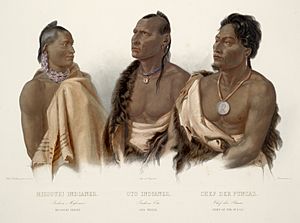Missouria facts for kids
The Missouria (say: Miss-ZUR-ee-uh) are a group of Native American people. They call themselves Niúachi (say: Nee-OO-ah-chee), which means "People of the River Mouth." They first lived near the Great Lakes in what is now the United States, long before Europeans arrived. The Missouria speak a language called Chiwere, which is part of the Siouan language family. They are closely related to the Iowa and Otoe tribes.
Historically, the Missouria lived near important rivers like the Grand River and the Missouri River. They also lived near where the Missouri River meets the Mississippi River. Today, most Missouria people live in Oklahoma. They are part of the Otoe-Missouria Tribe of Indians, with their main office in Red Rock, Oklahoma.
| Total population | |
|---|---|
| fewer than 1393 | |
| Regions with significant populations | |
| United States (Oklahoma, previously Missouri) | |
| Languages | |
| English, Chiwere language | |
| Religion | |
| Christianity (Protestant and Roman Catholic), Native American Church | |
| Related ethnic groups | |
| Otoe, Iowa, Ponca, and Ho-Chunk |
Contents
What Does "Missouria" Mean?
The name "Missouria" comes from a word in the Illinois language, Wimihsoorita. This name means "One who has dugout canoes."
In their own language, the Missouria call themselves Niúachi or Niutachi. This means "People of the River Mouth." Other tribes had different names for them. For example, the Osage called them Waçux¢a.
The state of Missouri and the Missouri River are both named after this tribe.
A Look at Missouria History

The Missouria people have a long history. Their stories say they once lived north of the Great Lakes. Around the 1500s, they started moving south. By the 1600s, they lived near where the Grand River meets the Missouri River.
Their traditions also tell a story about how they separated from the Otoe tribe. This happened because of a love story between the children of two tribal chiefs.
Challenges in the 1600s
The 1600s were a tough time for the Missouria. Other tribes, like the Sauk and Fox, often attacked them.
Also, many Missouria people got very sick and died from diseases like smallpox. These diseases were brought by Europeans and were new to the Native American people.
In 1673, a French explorer named Jacques Marquette met the Missouria. This meeting helped start trade between the Missouria and the French.
Moving West and New Alliances
Later, the Missouria moved west of the Missouri River, into land where the Osage tribe lived. During this time, they learned to use horses and hunted buffalo.
In the early 1720s, another French explorer, Étienne de Veniard, Sieur de Bourgmont, visited the Missouria. He married the daughter of a Missouria chief. They lived nearby, and Veniard helped create friendships between the French and the Missouria. He even built a trading post called Fort Orleans in 1723.
Hard Times and Joining Forces
Around 1730, the Sauk and Fox tribes attacked the Missouria again. This attack was very serious, and many Missouria people were killed. Most of the survivors joined with the Otoe tribe. Some also joined the Osage and Kansa tribes.
In 1829, there was another outbreak of smallpox. After this, fewer than 100 Missouria people were left. They all joined the Otoe tribe.
Treaties and Reservations
In the 1800s, the Missouria and Otoe tribes signed agreements with the US government. These agreements meant they gave up their lands in Missouri. They then moved to a special area called a reservation, located near the Big Blue River on the border of Kansas and Nebraska.
The US government later pressured the tribes to give up even more of their land in 1876 and 1881.
Changes in the Late 1800s
In 1880, the Otoe-Missouria tribes split into two main groups. One group was called the Coyote, who wanted to keep their traditional ways. The other group was called the Quakers, who wanted to adopt American ways of life.
The Coyote group moved to the Iowa Reservation. The Quakers got a smaller, separate reservation. By 1890, most of the Coyote group rejoined the Quakers.
Later, under a law called the Dawes Act, the US government divided tribal lands into individual plots for families. Any extra land was sold to European-American settlers. The Missouria tribe officially merged with the Otoe tribe.
Even though a law called the Curtis Act tried to get rid of tribal courts and governments, the Otoe-Missouria tribe created their own court system in 1900. In the early 1900s, many Missouria people were farmers.
After oil was found on their lands in 1912, the US government forced many tribal members off their land.
How Many Missouria People Are There?
In 1702, there were about 200 Missouria families. By 1780, there were about 1,000 people. But by 1829, after many challenges, only about 80 Missouria people were left, and they were living with the Otoe.
By 1910, only 13 Missouria people were counted separately. Since then, their population numbers are combined with those of the Otoe tribe, as they are now one united tribe.
See also
 In Spanish: Misuri (pueblo amerindio) para niños
In Spanish: Misuri (pueblo amerindio) para niños


